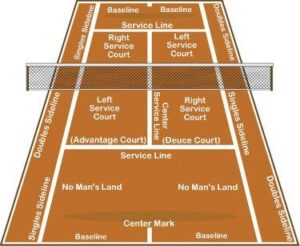How to Read Tennis Scores
Tennis is a dynamic and thrilling sport that has captivated sports enthusiasts for generations. However, for those new to the game, deciphering the scores can seem like a daunting task. In this article, we’ll break down the intricacies of tennis scoring, from love to match point, ensuring you never feel lost while watching a match again. Discover about How Many Serves Do You Get in Tennis
Reading tennis scores might seem confusing at first, but it’s quite straightforward once you understand the system. Tennis scores are divided into sets and games within sets. Here’s how to read tennis scores:
- Sets: A tennis match is typically played as a best-of-three or best-of-five set. To win a set, a player needs to be the first to win six games, but they must also be ahead by at least two games. If the score reaches 6-6, a tiebreaker might be played to decide the winner of the set.
- Games: Each set is made up of games. To win a game, a player must win at least four points and have a lead of at least two points over their opponent. The scoring system for points is as follows:
- No points: “Love“
- 1 point: “15”
- 2 points: “30”
- 3 points: “40”
- 4 points (winning point): “Game”
- Deuce and Advantage: When both players have won three points each in a game, the score is “Deuce.” From Deuce, a player must win two consecutive points to win the game. The first point won after Deuce is called an “Advantage” for the respective player. If they win the next point, they win the game. If the opponent wins the point, the score returns to Deuce.
- Tiebreaker: In some cases, a set might go to a tiebreaker when the score reaches 6-6. In a tiebreaker, points are counted as follows:
- 1st point: “1”
- 2nd point: “2”
- and so on…
The first player to reach 7 points with a lead of at least 2 points wins the tiebreaker and the set.
- Match: To win the entire match, a player must win the required number of sets (e.g., best of 3 or best of 5).
Here’s an example to illustrate:
Set 1:
- Player A: 3 games
- Player B: 4 games
Player B wins Set 1.
Set 2:
- Player A: 6 games
- Player B: 6 games
This set goes to a tiebreaker. Let’s say Player A wins the tiebreaker with a score of 7-5.
Player A wins Set 2.
If the match is best-of-three sets, Player A wins the match with a score of 1-1 (sets) and 7-5 in the tiebreaker.
Remember, the specific scoring terms can vary slightly depending on regional preferences or context, but the basic principles of tennis scoring remain the same.
Also, read the Article: Why Tennis 15-30-40
Introduction to Tennis Scoring
Tennis scoring may appear baffling at first, but it follows a logical pattern. To truly appreciate the intensity of a match, one must understand the intricacies of the scoring system. So, let’s dive in!
The Basic Structure of Tennis Scores
At its core, tennis scoring consists of points, games, sets, and matches. A match is won by winning a predetermined number of sets, and each set comprises games. Games are further broken down into points, with players vying for a point to win a game.
Understanding Points and Games
In tennis, points are counted as 15, 30, 40, and then game. However, if both players are tied at 40, it’s known as “deuce.” To win a game from deuce, a player must score two consecutive points, referred to as “advantage” and “game.”
Decoding the Language of Deuces and Advantages
When a game reaches deuce, players strive to gain the advantage to win the game. The player with the advantage only needs one more point to win, while the opponent must score two consecutive points to secure the advantage and subsequently the game.
Sets and Tiebreakers: A Comprehensive Explanation
A set comprises six games, and players must win at least six games with a margin of two to claim a set. If the set reaches 6-6, a tiebreaker is introduced. The first player to reach 7 points with a 2-point lead wins the tiebreaker, and the set concludes at 7-6.

Unraveling Match Points and Match Tiebreaks
To win a match, a player must win a specific number of sets, usually two out of three for men’s singles matches. In some cases, a match tiebreaker is played instead of a third set, with the first player to reach 10 points and a 2-point lead emerging victorious.
A Beginner’s Guide to Court Terminology
Navigating tennis scores becomes even more enjoyable when you understand court terminology. The area where points are contested is divided into service boxes, baselines, and sidelines. Knowing these terms enhances your viewing experience.
Scoring in Doubles Matches: How It Differs
Doubles matches have their own scoring nuances. With two players on each team, serving and receiving rotations add an extra layer of complexity to the scoring system. However, the basic point-game-set structure remains the same.

Keeping Score: Technological Advancements in Tennis
In the digital age, staying updated on scores is easier than ever. From mobile apps to live-streaming platforms, technology has revolutionized how fans engage with the sport in real-time.
Common Mistakes and How to Avoid Them
Beginners often make mistakes while keeping score. Confusion over terminologies and points can lead to misunderstandings. By familiarizing yourself with the scoring fundamentals, you can enjoy the matches without any hiccups.
The Excitement of Following Live Tennis Scores
Experiencing a match through live scores is a unique thrill. The ups and downs, the crucial points, and the suspense of a tiebreaker make for an adrenaline-pumping experience that keeps fans on the edge of their seats.
Conclusion
Tennis scoring, though initially perplexing, becomes a captivating aspect of the game once decoded. With this comprehensive guide, you’re equipped to follow matches, understand the language of deuces and advantages, and appreciate the thrill of every point won. So grab your popcorn, tune into a match, and let the world of tennis scores unfold before you.
FAQs
Q1: What is the purpose of the advantage in tennis scoring?
A: The advantage serves as a mechanism to break the tie at 40-40 (deuce) and determine the winner of the game.
Q2: How does a tiebreaker work in tennis?
A: A tiebreaker is played when a set reaches 6-6. The first player to reach 7 points with a 2-point lead wins the tiebreaker and the set.
Q3: Can a match end with a tiebreaker?
A: Yes, some matches, especially in the third set, can conclude with a match tiebreaker, where the first player to reach 10 points with a 2-point lead wins the match.
Q4: Are the scoring rules the same for doubles matches?
A: While the basic structure remains the same, doubles matches have unique serving and receiving rotations that add complexity to the scoring.
Q5: How can I keep track of live tennis scores?
A: You can use various apps and online platforms that provide live updates and scores of ongoing tennis matches.











